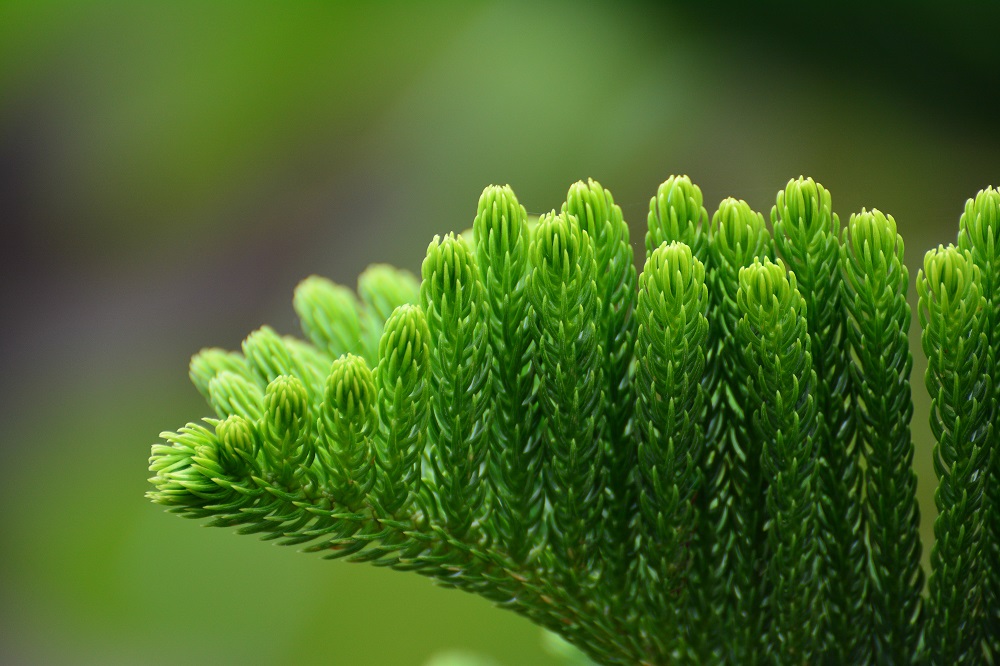Araucaria heterophylla / Araucaria araucana
Common Name:
Norfolk Island Pine / Monkey Puzzle Tree

General Information:
The Norfolk Island Pine is a large evergreen has a single upright trunk, tiered branching habit, and a narrow pyramidal or columnar shape. Eventually reaching a height of about 80 feet, the tree possesses a rapid growth rate. The tree would grow taller, but lightning frequently limits height growth in the eastern U.S. The dark green, 1/2-inch- long, individual leaves on young trees are lanceolate and look somewhat like spruce or fir needles at first glance. Mature leaves are somewhat contorted on twisted branches. Both leaf types appear on the tree at the same time. The trunk is often curved and swollen at the base and black. The large, spiny, 10 to 15-pound cones are rare in cultivation. Male and female cones are usually found on separate plants. They are native to South America and some Pacific islands.
The Monkey-Puzzletree, also an Araucaria, is a large, bizarre evergreen, 60 to 70 feet tall and 30 to 35 feet wide, which forms a loose, see-through, pyramidal shape with a straight trunk. The tree is so open in habit you could almost look at it and not see it. The leaves are dark green, stiff, with sharp needles densely arranged on horizontal, irregular, upwardly-sweeping branches. Monkey-Puzzletree makes an attractive, novelty specimen for a large, open yard or commercial landscape. It is normally planted only as an oddity someplace in the rear of a landscape out of view from most passers- by but could be the specimen feature in a large oriental landscape.
Family:
Araucariaceae
Lighting:
They prefer full sun but will survive in low light.
Temperature:
The Norfolk Island Pine is hardy in Zones 10 through 11. The monkey-puzzle tree is hardy in zones 7B through 11, but doesn’t grow well in overly hot areas.
Watering:
Allow the soil to dry out between waterings. Araucaria does not like damp soil.
Feeding:
The Samsons recommend organic fertilizer in spring and autumn. My mom feeds hers (houseplant, not bonsai) with ordinary ol’ houseplant food.
Pruning and wiring:
Can be wired at any time, but avoid wiring tender shoots. Wire should remain on the tree for a maximum of four months. Learning to prune can be difficult, as Geoline attests:
“These are not easily pruned because you can’t just cut a >frond or tip and expect new growth. In the spring, only prune new buds just when they are beginning to emerge and are still light green in colour. Remove just the tip which will include about three soft, needle-like leaves the same way you would go about bud pruning a Juniper. In a few weeks to a month, two new buds should take the place of the missing buds. If you pinch a bud wrong, new growth at the tip will cease. NIPs are one of those trees which you should practice bud pinching on several inexpensive practice plants first to develop an eye for pinching at just the right time.”
Araucaria makes especially good cascades, as they can be trained towards a light source. They also work as simulated palms.
Propagation:
From seed in spring - germination is slow, and is aided by the use of bottom heat. Cuttings may be taken from terminal shoots, not from laterals.
Repotting:
Every second year in spring, using fast-draining soil mix. Pests and diseases: No pests or diseases are of major concern. Scales, sooty mold, leaf spots.
Some species suitable for bonsai:
Araucaria araucana: monkey puzzle tree - A large, spreading tree, growing to 80 ft. and 30-40 ft. wide. Has two inch needles and branches which grow in a whorled pattern. Grows well on the West Coast - it is barely hardy in the Northeast and suffers from the heat in the South.
Araucaria heterophylla (also called Araucaria excelsa): Norfolk Island pine - a common houseplant, often sold decorated around Christmas! Has a pyramidal shape and short needles. It is grown outdoors in some areas of Florida and Southern California.
Bibliography:
Lesniewicz’s “Bonsai in Your Home”
Samson’s “Creative Art of Bonsai”
Mitchell’s “American Nature Guides: Trees”
Thomas (ed.) “The Hearst Garden Guide to Trees and Shrubs” USDA Fact Sheet ST-81 and ST-83.
Compiled by Sabrina Caine Edited by Thomas L. Zane
